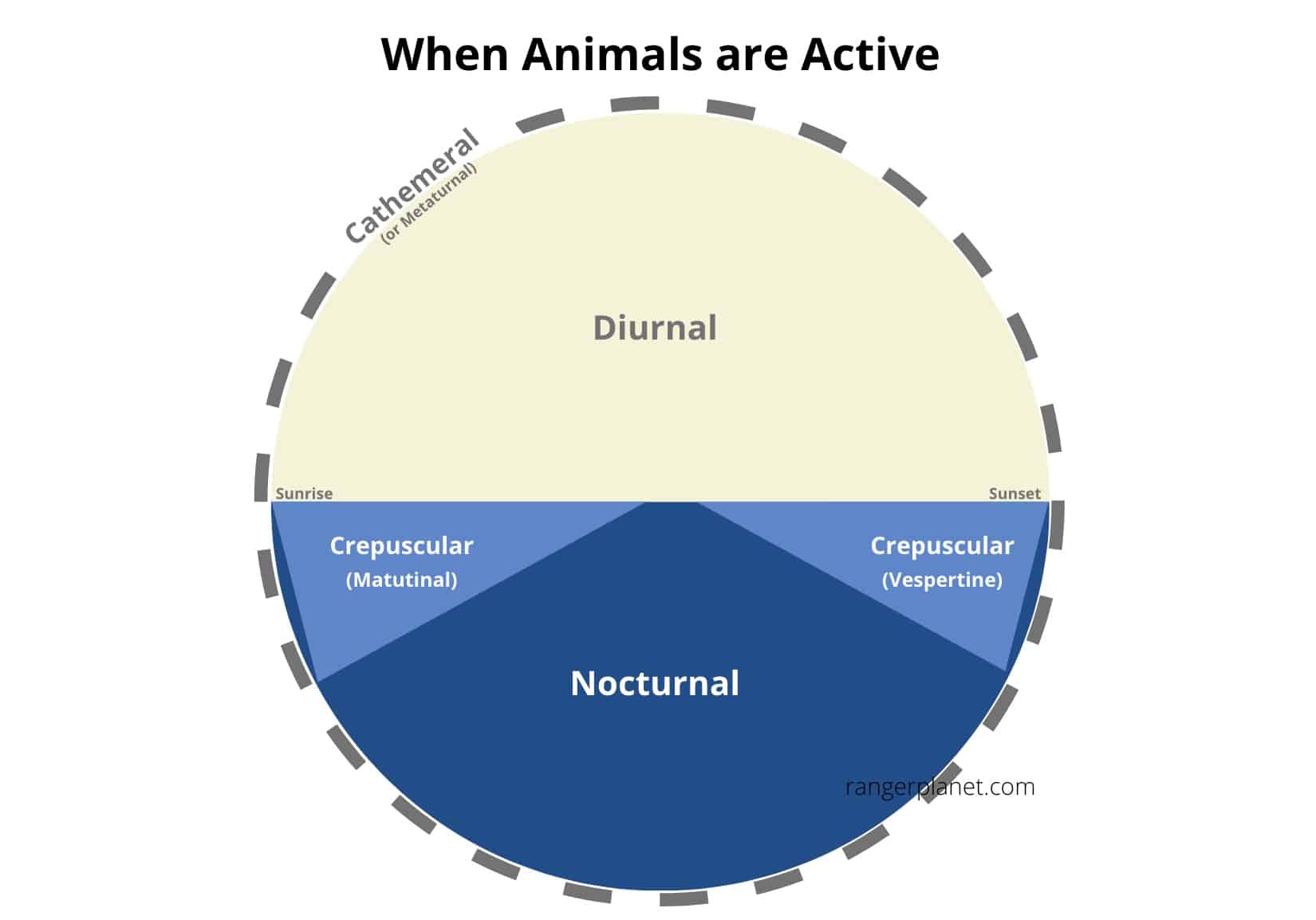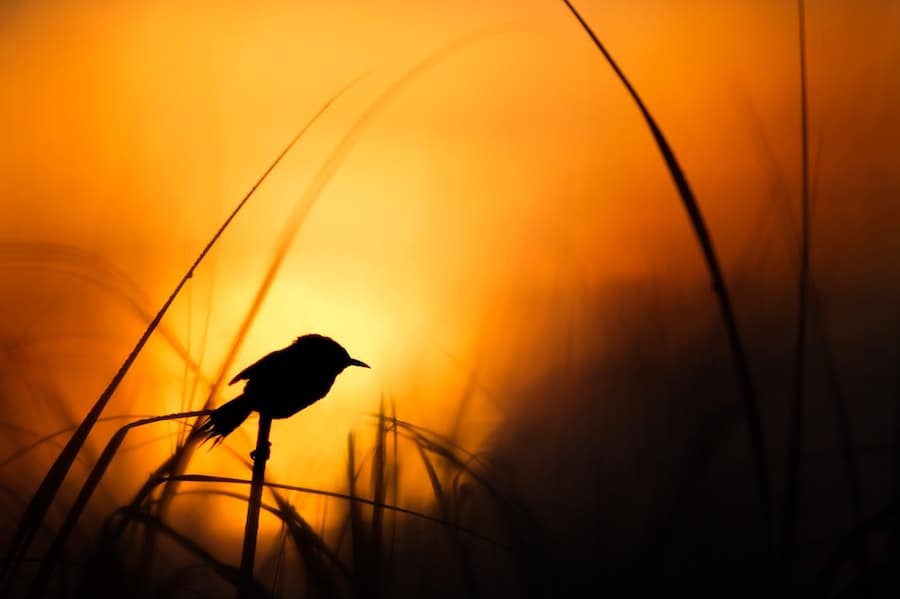So when are animals active? Humans can be active at all hours of the day and night. Some are busy working during the day, whilst others, a night shift.
But what about our furry friends from the Animal Kingdom? Are some animals only active during the daytime? And which animals get on with their lives during the hours of darkness and even before the sun rises?
Let’s discover more about when animals are active in my helpful post, giving you all you need to know about when the animal kingdom gets busy! Here’s a quick roundup to start us off…
Around 70% of animals are active at night – Nocturnal. Diurnal animals are active during daylight hours. Crepuscular refers to animals active around dusk (Vespertine), and/or dawn (Matutinal). Cathemeral (or Metaturnal) animals’ activity varies based on behavior and other factors.
Animals vary in their active hours due to many factors. We’ll explore these a little more shortly.
Read on, or watch the video below from the Ranger Planet Youtube Channel.
Let’s start by exploring more about why animals – similar to their shift-working humans – often have different active periods during 24 hours.
Here’s an infographic that outlines the approximate periods of the day and night when these periods occur.

Why animals are active at different times, days and seasons.
In general, evolution in the animal kingdom has taken place which fully takes advantage of all opportunities.
The unique roles of each animal have evolved to ensure that they can utilize and optimize their environment and the world around them.
For this reason, some creatures take advantage of daylight hours. Others, roughly 70%, have evolved to live and hunt in the darker, cooler, and more humid nighttime.
Sharing the environment
The lighter, warmer, and dryer environment of daytime suits many creatures, including most of the primate kingdom.
By sharing the load day and night, animals can max out their environment and occupy the same territory without the need for competition for space.
This is more important when it comes to the challenge for food and hunting grounds.
Animals activity depends on many factors
An animal’s wakeful times can depend on many factors. These can include:
- Temperature
- Prey
- Predators
- Light levels
- Humidity
The ecosystem makes use of symbiotic activity times
The whole ecosystem is designed in intricate measure around these kinds of concepts. For example, plants follow rules evolved by their diurnal and nocturnal pollinators.
Many flowers will open during the morning in order to attract bees that are more active during the earlier part of the day.
Alternatively, some flowers, like the moonflower, open during the evening until after sunrise in order to attract nighttime pollinators. They even have white flowers that help them to be found at night. And often fragrances from night bloomers can be heightened.
So let’s explore deeper by looking at creatures that are ready to start their day when the sun comes up.
Diurnal
Diurnal creatures wake and sleep with the rising and the setting of the sun. For instance, a turtle may be diurnal because it is cold-blooded.
So it will need to acclimatize to the temperature around it – but also to warm itself, it needs to bask in the sun.
That means that it has to be awake and active during the day.
Bald eagles and hawks are also awake with sunrise as this is when their prey is active, such as squirrels, and chipmunks.
Diurnal animals function less easily at night
The level of light intensity can be orders of magnitude dimmer at night.
So although animals who have adapted to living in the dark hours of nighttime can distinguish the difference between colors and contrasts of the nocturnal world, diurnal animals have limited ability.
It’s interesting to understand that some diurnal animals aren’t able to distinguish anything at all.
Circadian timing system
Along with their nocturnal cousins, diurnal animals share a common circadian timing system.
This is what we have more commonly known as a ‘body clock’ which controls behavior rhythms such as:
- Sleeping
- Waking
- Feeding
- Fasting
- Physiology
As I mentioned earlier, most primates are diurnal (which includes humans). Other common diurnal creatures include many mammals, birds, and reptiles.
Being busy during both day and night is the most common animal activity group.
Nocturnal
Initially, most animals were diurnal, but adaptations that allowed some animals to become nocturnal are why many – especially mammals – evolved successfully.
This move to nighttime living and hunting allowed animals to avoid certain predators …and hunt with less competition.
Nocturnal animals have developed over the years with many useful traits to help them live and be active in the dark. Including:
- Visual sensitivity to distinguish colors, and to detect faint movements
- Learning visual landmarks
- Orienting to the faint polarization pattern produced by the moon,
- Navigating by using the constellations of stars in the sky.
Body clock and nocturnal animal activity
As we saw earlier, it’s the body clock or circadian rhythms that are responsible for the ability of nocturnal animals to change their behavior in response to light and dark.
A nocturnal animal also has ‘clocks’ within its internal organs such as pancreas, heart, and liver which help to determine when it is active either feeding or fasting, during the hours of darkness.
Examples of nocturnal animals are bats, skunks, aardvarks, and owls. You’ll find another list of examples further below.
Let’s move on to crepuscular activity…
Crepuscular
Crepuscular comprises two groups. Matutinal animals are more active at dawn, such as deer and coyotes. And vespertine animals are active during twilight hours, such as moths and bats. Many crepuscular animals fall into both and are considered to have a bimodal activity pattern, such as rabbits.
The term matutinal is derived from the Latin word mātūtīnus, meaning ‘pertaining to the morning’. Whereas vespertine is derived from the Latin word vesper, simply meaning evening.
Dawn includes the hours where light from the sun provides visibility, but the sun has not yet crested the horizon. Twilight is the time of day that falls between day and night when there is light still available, but the sun is below the horizon. Twilight is also known as dusk or predawn.
This is different from animals that are nocturnal and diurnal.
Some active crepuscular animals may also be active during days with low light levels, such as an overcast day, or active during the night when there is more light, such as by moonlight.
You might also want to know where deer sleep.
Many animals are crepuscular
Similar to their diurnal relatives, Many familiar mammal species are crepuscular, including some bats, hamsters, housecats, stray dogs, rabbits, ferrets, and rats.
Other crepuscular mammals include members of the large cat family such as jaguars, ocelots, bobcats, wombats, wallabies, and hyenas.
Some birds such as the barn owl and nightjar fall into the crepuscular – vespertine group. A vast array of insects including many moths are also active during the hours of dusk and twilight.
So we can understand a little more easily about crepuscular animals, let’s discover matutinal and vespertine animals who slot into crepuscular activity at either end of the day.
Matutinal
Matutinal is a crepuscular animal that is active more during the early morning or predawn. Predawn is the hour before the sun rises.
It’s during this time these animals are active and busy carrying out their important business for the day, such as foraging, hunting, or mating.
During these hours there may be more food available than for their nocturnal cousins, which has ensured their adaptation.
It may also help these animals to avoid predation by other animals who are active during the day and nighttime.
Matutinal examples include bees, gerbils, rats, and other rodents.
Vespertine
The name ‘Vesper’ was a type of prayer practiced back in medieval times relating to the evening. It’s from this word we arrived at an animal who is known as a vespertine.
These animals use the low light of dusk before sunset to hunt and mate. Low light levels mean they can hunt more effectively.
These animals use the diffused light to hunt out their diurnal prey who may be tired from a day’s activity and are more able to catch them unawares.
The vespertine group of animals mainly includes insects, such as moths and flies, and species of bats and owls.
Similar to their matutinal cousins, these animals can also fall into the crepuscular group – but will hunt mainly at twilight rather than early morning.
Cathemeral
Cathemeral animals are categorized as active either as nocturnal (nighttime), diurnal (daytime), or crepuscular (dawn and/or dusk). And distribute their time evenly among these categories. Some animals can move across from one category to another where it suits them to do so.
Reasons for an animal being cathemeral can include factors such as the availability of food, chances of predation, or temperature fluctuations during different seasons.
Below I’ve added a roundup of the category names and their typical hours of activity…

| Time period | Hours of activity |
|---|---|
| Diurnal | Daylight hours |
| Nocturnal | Nighttime hours |
| Crepuscular (Matutinal) | 1-2 hours before sunrise |
| Crepuscular (Vespertine) | 1-2 hours after sunset |
| Cathemeral (or Metaturnal) | Times vary, daily and/or seasonally |
Example animals for each category
Here’s a list of examples of animals that fall into each of these categories. There are exceptions though. For example, most birds are Diurnal, but the Owl is mostly nocturnal. The bobcat is crepuscular in both matutinal and vespertine time periods but can also be cathemeral.
| Diurnal | Nocturnal | Crepuscular (Matutinal) | Crepuscular (Vespertine) | Cathemeral (or Metaturnal) |
|---|---|---|---|---|
| Turtles | Owls | Bees | Moth | Lemur |
| Most Primates | Rodents | Porcupines | Gnats | Koalas |
| Most Mammals | Foxes | Coyotes | Bat | Lions |
| Most Birds | Hedgehogs | Rabbits | Rabbits | Frogs |
| Reptiles | Badgers | Bobcats | Bobcats | Bobcats |
And to finish on…
I hope you’ve enjoyed this helpful article which has given you some information on classifications of animals according to their activity!
It’s amazing to think that for the animal kingdom, all times of the day and night can be busy, busy, busy!
If you would like to find out more facts and information about your favorite animals, don’t forget to check out my other articles! Here’s are some of the most popular articles…
Popular articles…
Difference between: species and genus, variety and species, or varieties and subspecies.

